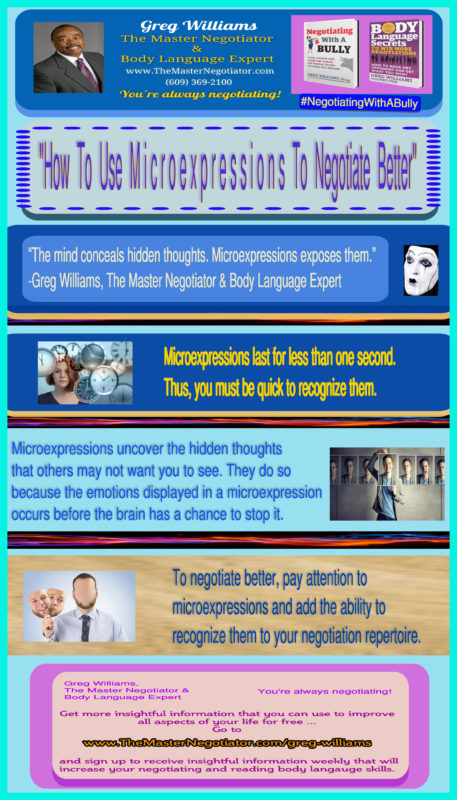How to Use Micro-Expressions to Negotiate Better
How to Use Micro-Expressions to Negotiate Better https://csuiteold.c-suitenetwork.com/advisors/wp-content/themes/csadvisore/images/empty/thumbnail.jpg 150 150 Greg Williams, MN, CSP https://secure.gravatar.com/avatar/1f08a50bcaed92eae0990a65c7808a62?s=96&d=mm&r=g
“The mind conceals hidden thoughts. Micro-expressions expose them.” -Greg Williams, The Master Negotiator & Body Language Expert
Are you aware that you can see the thoughts of other people? It’s not a magic trick. It’s accomplished by observing micro-expressions. Microexpressions are displays of emotion. They last for less than a second. They occur before the brain has a chance to alter the displayed emotion. Thus, the display is a genuine reaction to the stimulus that caused the emotion to be displayed.
There are seven microexpressions that are generic to everyone on the planet. That means if a stimulus occurred to someone in Europe or Asia, or anywhere in the world, the reaction would be the same.
This article identifies the seven microexpressions and how their recognition can be used in a negotiation.
Fear – Why do we become frightened? In part, it’s a way we protect ourselves. But fear can be debilitating too. In a negotiation, accurately detecting fear will give you an advantage. To obtain that advantage, you must know what the other negotiator is fearful of.
When detecting genuine fear, look for raised eyebrows, widened eyes, and parted lips with the bottom lip protruding downward.
Anger – People become upset in degrees. When it reaches a point of nontolerance, that’s when it becomes anger.
When negotiating, always be mindful of the other negotiator’s temperament, as well as your own. In both cases, when one loses one’s cool, that person can become irrational. Manipulation can easily occur at that time. Thus, they’re opportunities contained in such a mindset if you know how to advantage your position.
There are two main differences between the displayed microexpressions of fear and anger. With fear, eyebrows are raised and they’re lowered when displaying anger. In addition, with anger, one’s nostrils will flare like what a bull might exhibit prior to charging.
Disgust – In a negotiation, this is a temperament that we see when someone is not in agreement with our statement, offer or counteroffer. The other negotiator may say yes to the offer. But if he has his upper lip lifted and his nose turned up in a wrinkle while doing so, he just displayed the microexpression denoting disgust. It’s important to note the distinction between his words and actions because his statement of agreement is not as firm as his body language is indicating.
Surprise – Expressions of surprise can be good or bad (e.g. That’s better than I thought, or there’s no way I’d go for that.) You can recognize surprise by raised eyebrows, wide eyes, and a mouth that’s agape. Fear and surprise have these characteristics in common.
When negotiating, note if the expression of surprise stems from happy or sad expectations. If the other negotiator is too happy about an offer you’ve extended, you might consider reducing it.
Contempt – This gesture is conveyed by a sneer with one corner of the mouth turned upward. The meaning is, “I’m not enamored with this – I might think it’s insulting.’
Take note when you observe this gesture because it can lead to disgust and then anger.
Sadness – When sadness is displayed it’s done through drooping eyelids, lips turned down, and a change in the voice’s inflection and tonality.
If a negotiator displays sadness, it may stem from him realizing that you have the upper hand and there’s no negotiation wiggle room. If that’s a reality, don’t beat him up. You don’t want to turn that into anger, which might lead to unimagined responses.
Happiness – You’ll see this in the form of wide-eyes, a smile, raised cheeks, and a degree of exhibited gaiety.
When perceiving happiness, take note on what caused it but don’t let your guard down. If it’s genuine, you’ll sense an easy flow in the negotiation. If contrived, it may be an attempt to lull you into a false sense of security.
Negotiators look for advantages in every negotiation. Being able to accurately detect microexpressions can be the advantage you need. So, if you want greater advantages during your negotiations, look for the advantages that microexpressions offer. You’ll be a greater negotiator with greater outcomes … and everything will be right with the world.
Remember, you’re always negotiating!
After reading this article, what are you thinking? I’d really like to know. Reach me at Greg@TheMasterNegotiator.co
To receive Greg’s free “Negotiation Tip of the Week” and the “Sunday Negotiation Insight” click here http://www.themasternegotiator.com/greg-williams/
# microexpressions #Power #Powerful #Emotion #Business #Progress #SmallBusiness #Negotiation #NegotiatingWithABully #Power #Perception #emotionalcontrol #relationships #HowToNegotiateBetter #CSuite #TheMasterNegotiator #ControlEmotions

